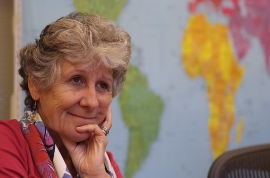Wisdom of the Outliers
By Taylor McNeil
A deceptively simple approach is solving some of the world’s most intractable social problems

“Sometimes the discovery of what has been working completely threatens the status quo, the taboos, the ways things have been done so far,” says Monique Sternin. Photo: David F. Gasser
When Jerry and Monique Sternin arrived in Vietnam in 1990, they had to work fast. They had been given just six months to come up with a way to combat widespread childhood malnutrition in the Vietnamese countryside. Previous efforts by outsiders had all failed, so they knew they needed to take a very different tack.
Instead of heading in with ready-made solutions, the Sternins went to four rural villages to listen and ask questions. The most important question was this: are there any families here that have children who are thriving?
Indeed there were a few, and the Sternins quickly sought them out. It turned out those villagers fed their children differently than their neighbors. They gave them smaller, more frequent meals and supplemented the staples with small bits of shrimp, crab and sweet potato greens. They fed them even if they had diarrhea. Those small changes meant these children thrived while their neighbors’ kids did not.
That approach—looking for local people who had solved the problem and engaging the community to emulate them—soon became the basis for the government’s childhood nutrition program in rural Vietnam. After only six months, it reduced malnutrition in these poor villages by an astonishing 65 to 80 percent.
The project in Vietnam became the basis for the Sternins’ work for the next two decades. In 2001, they came to the Friedman School, and founded a program centered on this new approach. Monique Sternin, who has led the efforts since her husband died in 2008, recently published a new book about their work, The Power of Positive Deviance: How Unlikely Innovators Solve the World’s Toughest Problems (Harvard Business Press), written with her late husband and co-author Richard Pasquale. It contains compelling case histories from Mexico to Indonesia.
Calling the approach “positive deviance” is admittedly awkward. What it means is this: in a community with a serious problem—in health, nutrition, education—identifying the people who deviate from the norm and find solutions on their own is crucial, as is the need for active community engagement. “It has to be a problem that they want to solve,” says Sternin, who is director of the Positive Deviance Initiative at the Friedman School. “It will motivate people to change.”
What’s needed for this grassroots approach to work is “a problem that’s really intractable, that’s worth the effort,” says Sternin, who grew up in France. Having an involved local leadership is also crucial. “The people with the money and power must relinquish control and let the community re-frame the problem,” she says. “They need to let the people define the problem the way that they see it—and it actually does work.”
Communal Solutions
Sternin points to work she did in the North-West Frontier Province in Pakistan, hard up against the Afghan border, a rugged area with extremely high infant mortality rates—85 deaths per 1,000 births. Working with Save the Children in 2002, she and her team met with the Pashtun village leaders—all men, of course—and eventually steered the conversation to ask about local families whose infants had all survived. What were they doing differently?
Almost all village families delivered babies at home, and most followed traditional practices. They used a bamboo knife to cut the umbilical cord, fed newborns honey for three days before breast-feeding and often laid the babies on the mud floors. But there were a few households that did not follow these practices: they used clean razor blades to cut the umbilical cord, began breast-feeding immediately and put their infants to sleep on pillows. In those families, the children survived.

“It has to be a problem that they want to solve,” says Monique Sternin, celebrating with girls in Egypt.
After word spread, some villagers began to track the success of these non-traditional methods—and then began to imitate them. “The men are still monitoring pregnancy outcomes,” Sternin told me. “That’s what’s important and worth the effort—not only is the problem solved, but it builds the capacity of the community to sustain the gains and go on and do something else.”
Seeking out the anomalies is an approach that succeeds beyond the developing world. In 2006, the Pittsburgh Veterans Hospital contacted the Sternins to help with a campaign to eradicate the lethal MRSA bacteria from its wards. The hospital had tried many “best-practice” efforts, but the infection rate among patients remained alarmingly high.
The Sternins’ team held small meetings with all hospital employees—from the doctors and nurses to cleaning and kitchen staff—to learn what might stop the MRSA infections. The large investment of time and effort—meetings with almost 400 people—paid off. Hospital staffers who had earlier felt ignored spoke up with new, useful ideas. Nurses felt empowered to remind doctors to wash their hands between patients. New routines were established as a real sense of community responsibility took hold. The result was dramatic: in a little more than a year, the MRSA infection rate dropped more than 50 percent.
“It’s a non-expert driven approach,” Sternin says. “To find the expertise and answers from within is very refreshing for workers, instead of being told what to do.”
These successes were matched in other—and very different—circumstances detailed in the book: reintegrating rebel female soldiers in civil society in Uganda; curtailing female circumcision in Egypt; lowering school dropout rates in Argentina; increasing a company’s pharmaceutical sales in Mexico. There were failures, too. In one case, conflict between an Indian Health Services hospital and the local reservation community proved insurmountable. “Failure happens, but it’s usually because of a lack of leadership support,” Sternin says.
The Importance of Buy-in
Because the approach highlights community members who do things differently than everyone else, there is always the potential for conflict. “When you are involved in behavioral and social change, it’s a very dangerous business,” Sternin says. “Sometimes the discovery of what has been working completely threatens the status quo, the taboos, the ways things have been done so far.” And that’s why the buy-in of the local leadership is so important. “They have the power to say, ‘Let’s look at this.’ ”
As the approach has become more widely known—it was featured in Atul Gawande’s Better: A Surgeon’s Notes on Performance, for instance—some have wondered how to expand it even further. But Sternin says the approach always has to be tailored to local circumstances.
“It’s an approach, not a model,” she says. If you lock it down to action plans, “it doesn’t work anymore. By definition we have to be flexible. It is adapted to all the cultural and social contexts that give it its relevancy.”
Even though the positive deviance (PD) approach is very labor intensive, it is increasingly seen as a potential game changer in many circumstances. In the nutrition field alone, it is used worldwide, Sternin says. Organizations such as the World Food Programme, UNICEF, and foundations have used the approach for community-based programs combating childhood malnutrition.
Training others to take the approach out into the world is one of the main tasks of the Positive Deviance Initiative, Sternin adds. “There is also an active advocacy component to promote the use of this approach for behavior and social change via virtual and programmatic outreach,” she says.
“If you’re able to let people express their fears and longings,” Sternin says, “they will be open to finding out what works for them themselves.”
Taylor McNeil can be reached at taylor.mcneil@tufts.edu.
